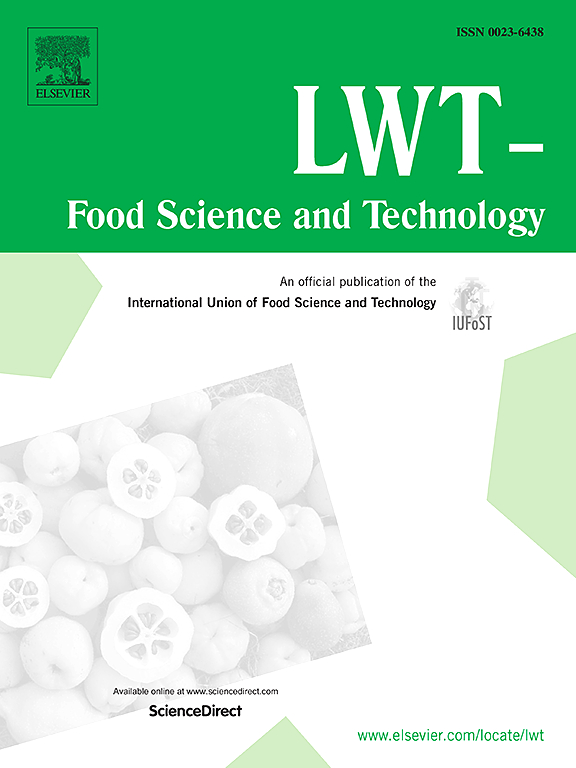Gelatin/ pectin based composite films re-enforced with mango peel extract loaded zein nanoparticles and zinc oxide nanoparticles: Enhanced mechanical and functional properties
IF 6
1区 农林科学
Q1 FOOD SCIENCE & TECHNOLOGY
引用次数: 0
Abstract
Gelatin (G), pectin (P), or their composite (G/P) films incorporated with mango peel extract (MPE) loaded zein nanoparticles (MZe), and zinc oxide nanoparticles (ZnO) were fabricated and characterized. MZe nanoparticles loaded with 8 mg/mL of MPE showed higher encapsulation efficiency (96.0 %), higher zeta potential (38.1), and lower PDI (0.13) compared to the lowered concentration of MPE. When films were fabricated using various combinations of polymers and nanofillers, scanning electron microscopy (SEM) revealed that the G/P composite with MZe-ZnO had compact and continuous structural integrity compared to other combinations. In addition, the G/P-MZe-ZnO composite film showed higher tensile strength (28 MPa) and elongation at break (28.4 %) compared to other formulations. Furthermore, incorporation of MZe and ZnO NPs in G/P composite film significantly enhanced hygroscopicity (>90 °C), light barrier properties (48.5 % transmittance), antioxidant (90.5 % DPPH radical scavenging activity), and antibacterial (Bacillus subtilis inhibition) activities. The results suggested that MZe and ZnO could be used as nanofillers to enhance the mechanical and active properties of the G/P composite film. The developed combination of composite film incorporated with nanofiller can be used as an active food packaging application.
明胶/果胶为基础的复合薄膜与芒果皮提取物加载玉米蛋白纳米颗粒和氧化锌纳米颗粒强化:增强机械和功能特性
制备了明胶(G)、果胶(P)或其复合膜(G/P),并对其与芒果皮提取物(MPE)、玉米蛋白纳米粒子(MZe)和氧化锌纳米粒子(ZnO)的复合膜进行了表征。与MPE浓度较低的MPE相比,负载8 mg/mL MPE的MZe纳米颗粒具有较高的包封率(96.0%)、较高的zeta电位(38.1)和较低的PDI(0.13)。用不同的聚合物和纳米填料组合制备薄膜时,扫描电子显微镜(SEM)显示,与其他组合相比,含有MZe-ZnO的G/P复合材料具有致密和连续的结构完整性。此外,G/P-MZe-ZnO复合薄膜的抗拉强度(28 MPa)和断裂伸长率(28.4%)均高于其他配方。此外,MZe和ZnO NPs在G/P复合膜中的掺入显著提高了吸湿性(>90°C)、透光性(48.5%)、抗氧化性(90.5%的DPPH自由基清除活性)和抗菌(抑制枯草芽孢杆菌)活性。结果表明,MZe和ZnO可以作为纳米填料提高G/P复合膜的力学性能和活性。所开发的复合膜与纳米填料的组合可作为活性食品包装的应用。
本文章由计算机程序翻译,如有差异,请以英文原文为准。
求助全文
约1分钟内获得全文
求助全文
来源期刊

LWT - Food Science and Technology
工程技术-食品科技
CiteScore
11.80
自引率
6.70%
发文量
1724
审稿时长
65 days
期刊介绍:
LWT - Food Science and Technology is an international journal that publishes innovative papers in the fields of food chemistry, biochemistry, microbiology, technology and nutrition. The work described should be innovative either in the approach or in the methods used. The significance of the results either for the science community or for the food industry must also be specified. Contributions written in English are welcomed in the form of review articles, short reviews, research papers, and research notes. Papers featuring animal trials and cell cultures are outside the scope of the journal and will not be considered for publication.
 求助内容:
求助内容: 应助结果提醒方式:
应助结果提醒方式:


